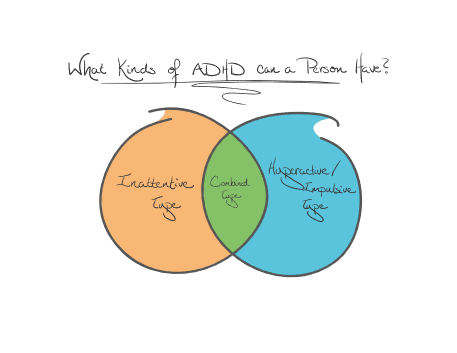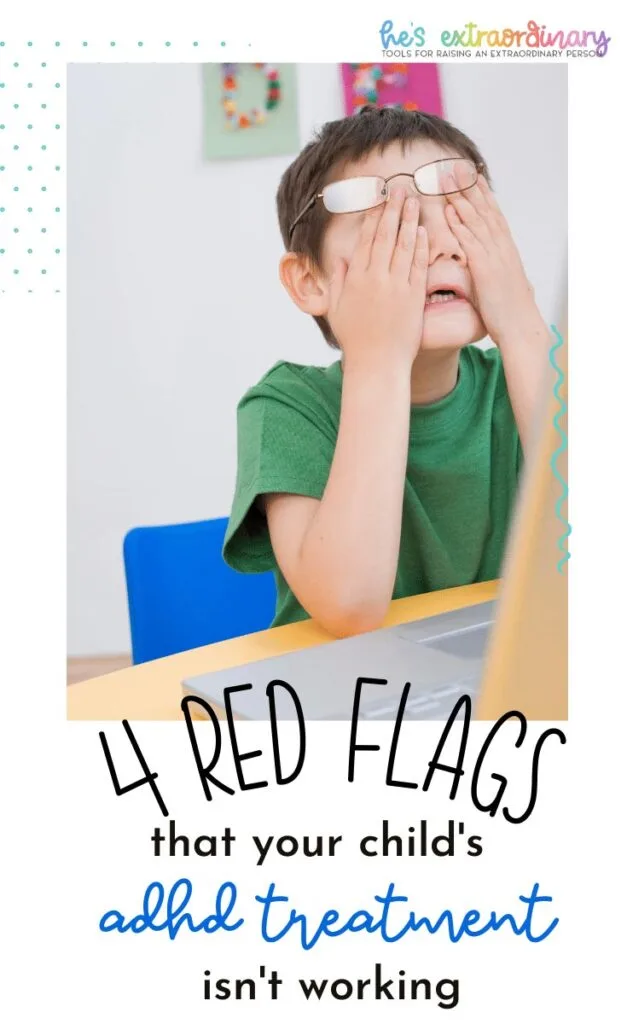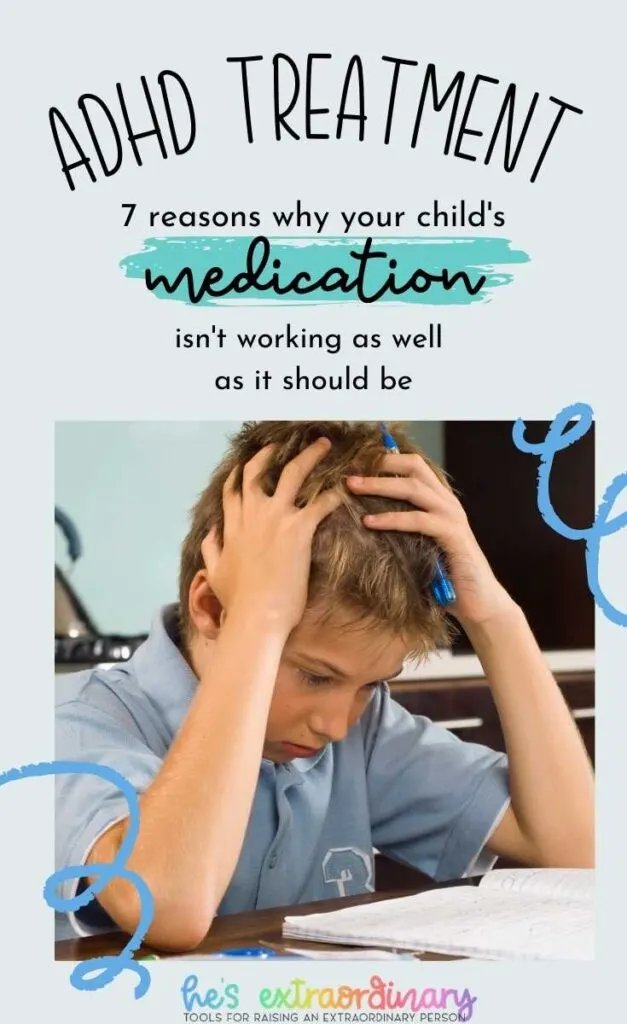What’s inside this article: How to tell if your child’s ADHD treatment is, or isn’t working. Includes common factors that affect the success of the treatment, how to manage negative side effects, and a free printable treatment tracker you can use for doctor’s appointments.
It doesn’t matter if you’re just starting a new treatment plan, or you’ve been following the same one for a while. It’s equally important to monitor and assess if your child’s ADHD treatment is working and you can do this by tracking both their symptoms and the side effects.
How the symptoms of ADHD are managed is a very individualized experience. There is no one treatment or medication that works for everyone. As well, it’s unlikely you and your doctor will get things right on the first try.
Most of the time, finding the right ADHD treatment involves trying several different options until you discover which one is the best fit.
Treatment for ADHD can include a combination of therapies, medications, supplements, and parent education.
The course of treatment for your child is decided based on their individual needs. You and your child’s doctor will work together to decide on what treatments to use to manage your child’s ADHD symptoms.
After you have decided on an ADHD treatment plan it’s important to follow it consistently and monitor the efficacy of the plan.
What is ADHD?
ADHD is a neurodevelopmental disorder – this means it’s related to the way the brain grows and develops.
It is not a behavioral disorder, that is a common misconception.
ADHD is defined as persistent problems with attention, organization, and/or hyperactivity and impulsivity that interfere with daily life or development.
There are three subtypes of ADHD: Inattentive type, h
These “types” of ADHD are a way that individuals with ADHD are categorized based on their needs. Everyone’s challenges and strengths vary and that is why ADHD treatments are different for everyone as well.
Related: How Does Omega-3 Affect Symptoms of ADHD?
Indicators that ADHD Treatment is Working
When treatment is working well, your child will benefit in many ways, and common challenges associated with ADHD will be easier to manage.
There are several good signs you can look out for.
1. Less Impulsive
When your child’s ADHD treatment plan is working well, your child will be less impulsive, both behaviorally and verbally.
For example, they won’t blurt out that answer in class – they’ll raise their hand and wait to be called on by the teacher. Or they won’t do silly/inappropriate things in order to grab the attention of others.
Kids will notice better control over their thoughts, too. Children with ADHD may experience racing thoughts – these are fast strings of thoughts that waste time, are often blown out of proportion, and don’t come to a rational conclusion.
If ADHD treatment is working well, these racing thoughts will diminish. It will be easier for your child to think about what is happening in the present moment and think more rationally.
2. Better Focus
Having better focus doesn’t mean that your child will be “zombie-like” or zeroed in on only a single thing at a time.
Actually, improved focus means your child should be able to focus on what they need to focus on in order to be productive.
Their focus should be able to be redirected, as needed.
Your child should be able to filter out distractions in order to complete a task.
3. Sleeping Well
Trouble sleeping – whether that be difficulty falling asleep, or staying asleep – is not only a common ADHD symptom, it’s also an extremely common side effect of ADHD medications.
Read: ADHD & Sleep – 6 Tips for a Better Night’s Rest
But just because it is common, doesn’t mean it’s something you should have to live with.
Restful sleep is crucially important for child development.
Your child’s brain needs sleep in order to work at its full capabilities, including being able to concentrate, learn new things, and think of new ideas.
Your body needs sleep to grow, regenerate cells, and maintain a healthy immune system.
4. Improved Memory
Recalling memories is one of the executive functions of the brain. It’s something that kids with ADHD often struggle with.
When your child’s ADHD treatment is working – they’ll be able to better recall the things they’ve learned. For example, they’ll be able to summarize a book after reading it or remember the answers during a test.
They may also remember things like phone numbers or people’s names more easily.
5. Increased Attention to Detail
With the ability to focus better, your child should also show improved attention to detail when their ADHD treatment is working well. They’ll start noticing things they wouldn’t have before.
Watch for signs of their attention to detail improving – like noticing spelling or grammatical errors, or missed questions on their schoolwork that would have been overlooked in the past.
Signs That ADHD Treatment Is Not Working
What red flags are you watching for as a sign that your child’s ADHD treatment isn’t working?
Any of the following problems could indicate that your current treatment plan needs to be modified.
1. The Absence of Positive Indicators
For starters – if any of the positive indicators discussed above are absent, that’s a good sign your treatment plan isn’t working as good as it should be
. So if your child is not focusing better, or they’re not less impulsive. If these are challenges you’ve addressed with your doctor, you should be expecting to see some change.
This includes difficulty sleeping. If your child’s having trouble sleeping due to their medication it’s important to address this with your doctor. It’s important your child gets adequate sleep.
2. “Zombie-Like”
You hear that phrase a lot when talking about kids who take medication to treat ADHD. However, the right medication should not make your child seem like a zombie. They shouldn’t be spaced out, or seem like they aren’t present.
It shouldn’t change your child’s core personality at all. They should remain their same, wonderful selves – it should just improve their ability to manage their ADHD symptoms.
3. Mood Changes
Any disruptions to your child’s mood is a red flag that their treatment plan is not working. This includes mood swings, aggressive behavior, depressive behavior, etc.
Your child’s moods should remain relatively consistent, with the intensity of their emotional responses matching the situation. In other words, there shouldn’t be any high peaks or deep lows.
It’s okay for them to have upset or excited moods at times but their emotional reactions shouldn’t be overly intense, unpredictable, or sporadic.
Related: 4 Natural ADHD Treatments
4. Appetite Loss
Another common side effect of stimulant medications is appetite loss. If you notice a change in your child’s appetite when beginning a new medication you shouldn’t be surprised. However, after several weeks once they have adjusted to the medication there should be an improvement.
You may notice your child starting to eat much more in the evening to make up for what they may have missed during the day.
That’s okay – but it’s important to make sure their weight and nutrition aren’t negatively impacted.
Your child’s doctor should closely monitor them for weight loss or signs of malnutrition. If weight loss becomes a concern you should discuss with your doctor whether or not you need to consider different treatment options.
Possible Reasons Your Treatment Plan Isn’t Working
There are many possibilities as to why a particular treatment plan isn’t working for your child. The most common reasons include:
1. Wrong Medication
Different people respond differently to medications. Individuals with ADHD present unique challenges that may make some medications work better for them than others.
2. Wrong Dose
The medication may be fine, but the dosage is off. Taking a dose that’s too high or too low can have negative effects. Your doctor should carefully titrate the dose of any medications and this can sometimes take 12 months or more.
3. Generic vs. Brand Name Medication
Although the key medical ingredient is the same, the fillers in generic versions can vary significantly.
These can cause unpleasant side effects in some people.
4. Wrong Time of Day
If you’re taking medication too early in the day, or too late it may not be effective when you need it. Or it may affect your sleep. Some individuals do well with extended-release medications, while some do better taking a fast-acting, lower dose twice a day. Discuss timing with your doctor.
5. Interactions
If your child is on more than one medication, or on other nutritional or herbal supplements – all of these things can potentially interact with one another.
You should discuss interactions with your doctor and/or pharmacist. You may need to take other medications at a different time of day or change them completely.
6. Incomplete Treatment Plan
If you’re using medication alone, your treatment plan may be incomplete. Medication can help children manage their symptoms but it can not solve all of their problems on its own.
The most effective ADHD treatment involves behavioral therapy, diet changes, and parent education as well.
Unfortunately, the number of children who actually receive behavioral therapy after their diagnosis is quite low. Vocalize your concerns for your child, you are their advocate.
7. Unmet Dietary Needs
Research shows that certain changes in diet can benefit some children with ADHD. One very important aspect is Omega-3. Omega-3’s are essential fatty acids used by the brain to produce dopamine.
ADHD has been linked to dopamine deficiency, and ADHD medications work by increasing the amount of dopamine that’s present in the brain.
However, if you don’t consume enough Omega-3, your body won’t have all of the ingredients it needs to make dopamine.
Read about this process and the benefits of Omega-3 supplements here.
Printable: ADHD Symptom and Treatment Tracker
Download the printable symptom tracker below and use it to track your child’s treatment. It can be hard to remember everything you need to discuss with your child’s doctor when you only get into their office once every few months.
Each day you score each component of the tracker on a scale of one to ten. Then, combine together to get your treatment plan’s total score out of 100.
If you’re consistently getting low scores or scores begin dropping lower and lower over time after being stable – then you know you need to discuss options with your doctor.
It’s a good idea to make a note of any other factors that may temporarily affect the score, too. For example, if your child has an illness their sleep, appetite, mood, etc may be temporarily affected.






Luke Smith
Tuesday 19th of November 2019
When kids notice that they're being able to take control and hold their thoughts and emotions, you can say that the ADHD treatment is working for them. I have this cousin who was born with ADHD, and my aunt has been tediously tending him. It seems like recommending an ADHD treatment program can ease the burden of my aunt a bit since my cousin can learn how to take care of his emotions, so I'll make sure to find one with a flexible schedule and affordable rate.